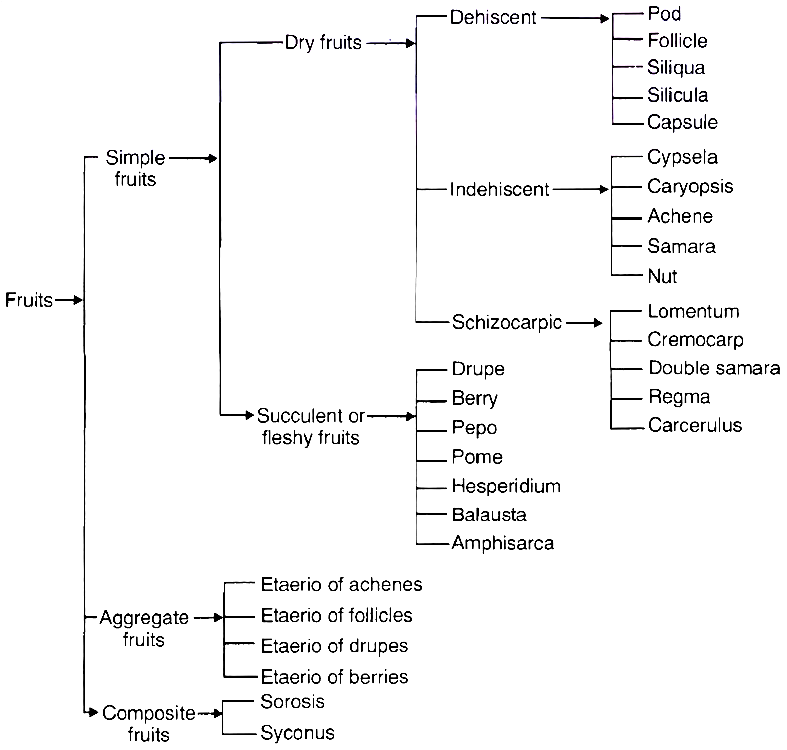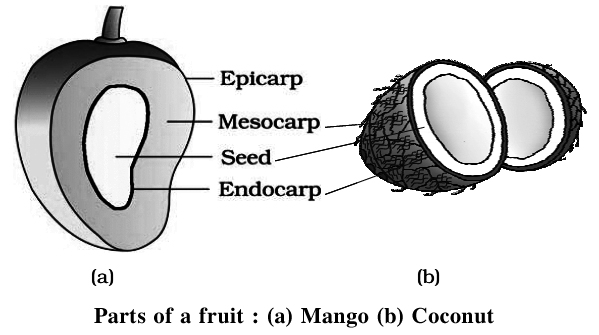- Books Name
- ACME SMART COACHING Biology Book
- Publication
- ACME SMART PUBLICATION
- Course
- CBSE Class 11
- Subject
- Biology
THE FRUITS
Fertilized and ripened ovary is fruit.
A fruit consists of (i) Pericarp (fruit wall)-developing from wall of ovary and may differentiated into epicarp, mesocarp and endocarp. (ii) Seeds-developing from ovules.
In some plants ovary grows into fruit without fertilization, such fruits are called parthenocarpic fruits.
They are seedless e.g., Banana, grapes, oranges.
The fruit which develops from ovary is called true fruit.
Most of the fruits are true fruits.
If any floral part other than ovary takes part in fruit formation , it is called false fruit (pseudocarp). e.g., Apple, Pear.
Schematic presentation of different kinds of fruits

Types of Fruits
1. Simple fruits
Fruit developing from the syncarpous ovary of the single flower with or without accessory parts is called simple fruit. Simple fruits are of following types:
A. Dry indehiscent fruits. They do not split or burst. Seeds are liberated only by the decomposition or destruction of pericarp.
Concept Builder
(i) Caryopsis. Develops from monocarpellary, unilocular ovary. Fruit wall or pericarp completely fused with seed coat. e.g., wheat, maize, rice (Graminae).
(ii) Achene. It develops from monocapellary, unilocular ovary. Fruit wall (pericarp) is not completely attached with seed coat (as that of caryopsis), e.g., Mirabilis.
(iii) Cypsela. Develops from bicarpellary, unilocular and inferior ovary. Calyx is hair like and called pappus which helps in dispersal of fruits (seeds), e.g., Sunflower, Sonchus, Zinnia, Taraxacum. It is characteristic fruit of family Compositae (Asteraceae).
(iv) Samara. Develops from superior ovary. Fruits are winged and wings develop from pericarp, e.g., Holoptelea, Dioscorea, Hiptage.
If wings in fruits develop from sepals they are called samaroid, e.g., Shorea (Sal), Dipterocarpus, Hopea.
(v) Nut. Develops from polycarpellary superior ovary. Pericap is hard (stony) and sometimes woody, e.g., Anacardium (cashew nut), Litchi (marking nut), Trapa (water chestnut) and Quercus (oak).
B. Dry dehiscent fruits. These fruits burst automatically and discharge their seeds.
Concept Builder
(i) Legume or pod. Dry, one chambered fruit developing from a superior and monocarpellary ovary. Mature fruit dehisces by both sutures or margins, e.g., Gram, lentil, pea.
(ii) Follicle. Develops from bicarpellary, ovary. Mature fruit dehisces by one suture only, e.g., Delphinium, Catharanthus.
(iii) Siliqua. Develops from bicarpellary, unilocular ovary with parietal placentation, dehiscence of fruits occur by both the halves from base to apex, e.g., Mustard, radish. This is characteristic fruit of family Cruciferae or Brassicaceae.
(iv) Silicula. A short, broad, flat siliqua with few seeds is known as silicula. e.g., Iberis, Capsella.
(v) Capsule. Develops from multicarpellary, syncarpous ovary. Dehiscence occurs by many ways.
(a) By Pores. Porocidal, e.g., Opium (Poppy), Argemone.
(b) By locules or valves. Loculicidal, e.g., Cotton.
(c) By Septa. Septicidal, e.g., Linseed.
(d) Septa breakdown into fragments. Septifragal, e.g., Datura.
C. Dry schizocarpic fruits. They are intermediate between dehiscent and indehiscent fruits. On maturation they break into a number of indehiscent parts (mericarp) or dehiscent parts (cocci).
Concept Builder
(i) Lomentum. Pod is constricted or chambered between the seeds into a number of one seeded compartments, e.g., Acacia, Mimosa, Arachis, Inga dulce, Tamarindus.
(ii) Cremocarp. Develops from bicarpellary inferior ovary. Fruit splits into two indehiscent one seeded mericarps, e.g., Coriander, cumin (Umbelliferae or Apiaceae).
(iii) Regma. Develops from tricarpellary, syncarpous, trilocular, superior ovary with axile placentation. Fruits split into three one seeded dehiscent units called cocci, e.g., Euphorbia, Ricinus (castor), Geranium, Jatropa.
(iv) Double samara. Just like samara, but at maturity splits into two one seeded samaras. e.g., Acer (maple).
(v) Carcerulus. Develops from bi-or multicarpellary, superior ovary. Fruits split into two, four or more indehiscent parts e.g., Ocimum, Salvia.
D. Fleshy or succulent fruits. These are of following types:
(i) Drupe. Mostly one seeded fruits with pericarp differentiated into epicarp, mesocarp and hard and stony endocarp, e.g., Mangifera indica (Mango-epicarp forms skin, mesocarp-fleshy, juicy and edible, endocarp is hard and stony), Cocos nucifera (Coconut-Mesocarp is fibrous which is used in making coir so called as fibrous drupe), Juglans regia (walnut).

(ii) Berry. One to many seeded fruits. Epicarp forms the outer skin. Middle thick and fleshy part is called mesocarp with a membrane like endocarp, e.g., Tomato, guava, papaya, grapes, banana, brinjal, chillies. Betel nut is a one seeded berry.
(iii) Pepo (hard walled berry). Develops from tricarpellary, syncarpous, unilocular and inferior ovary. Epicarp forms skin of fruit. Mesocarp and endocarp are fleshy and edible. Sometimes, fruits are bitter in taste due to tetracyclic triterpenes e.g., Cucumber, gourd, watermelon.
(iv) Pome. Develops from syncarpous inferior ovary which is surrounded by fleshy thalamus. So, true fruit lies inside the swollen fleshy and edible thalamus. It is false fruit or pseudocarp. e.g., Apple, pear. Edible part is fleshy thalamus.
(v) Hesperidium. Develops from multicarpellary, multilocular, syncarpous, superior ovary with axile placentation. The epicarp and mesocarp fused together to form skin or rind of the fruit. Endocarp projects inwards forming a number of distinct chambers. The juicy unicellular hairs are present on the inner side of the endocarp. e.g.,Orange and all citrus fruits.
(vi) Balausta. Develops from multilocular,syncarpous, inferior ovary. Epicarp is tough and leathery. Endocarp is membranous. Seeds are irregularly distributed inside the fruit. Juicy testa of the seeds is edible. The fruit has persistent calyx e.g., pomegranate.
(vii) Amphisarca. Develops from multicarpellary, syncarpous, multilocular and superior ovary. The epicarp is hard and woody, mesocarp, endocarp and swollen placenta are fleshy and edible e.g., Aegle marmelos (wood apple or bael), Feronia limonia (Kaith or elephant apple).
2. Aggregate fruits
Aggregate fruits are formed from polycarpellary, apocarpous ovary.
Each carpel develops into a fruitlet and all fruitlets together form an aggregate fruit.
An aggregate of simple fruits borne by apocarpous ovary of a single flower is otherwise known as 'etaerio'.
Aggregate fruits are of the following types -
(i) An etaerio of achenes e.g., Strawberry, Rose, Clematis.
(ii) An etaerio of berries e.g., Artobotrys, Polyalthia, Annona (custard apple)
(iii) An etaerio of follicles e.g., Delphinium, Michelia.
(iv) An etaerio of drupes e.g., Raspberry.
3. Multiple or composite fruits
The multiple fruit develops from the entire inflorescence. These fruits are of two types :
(i) Sorosis. These fruits develop from spike, spadix or catkin inflorescence. The flowers fuse together by their sepals or perianth and the whole inflorescence forms a compact mass e.g., Jackfruit, mulberry, pineapple.
(ii) Syconus. This fruit develops from hypanthodium inflorescence e.g., Ficus sp. (fig, gular, banyan, peepal). The fruitlets are achenial in nature.
Edible parts of some common fruits and their types


 Maria Habib
Maria Habib
